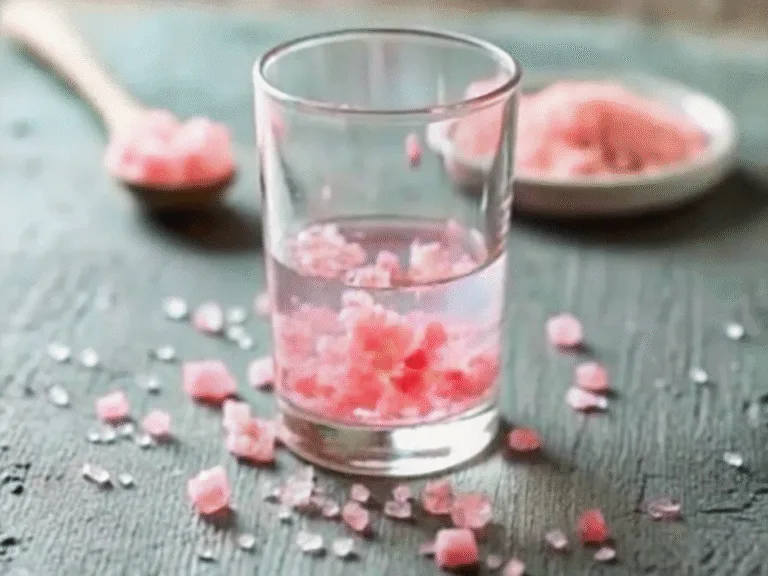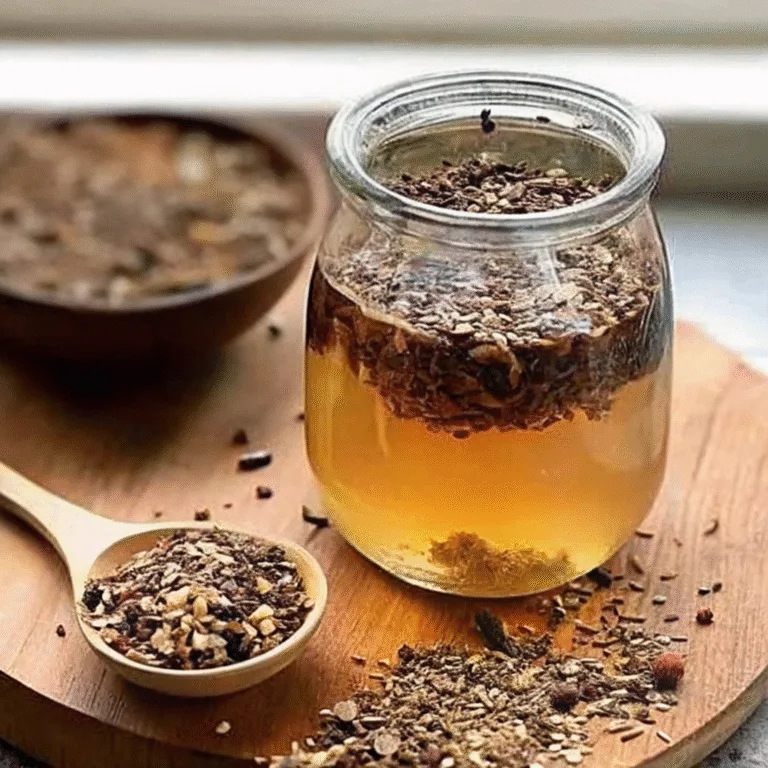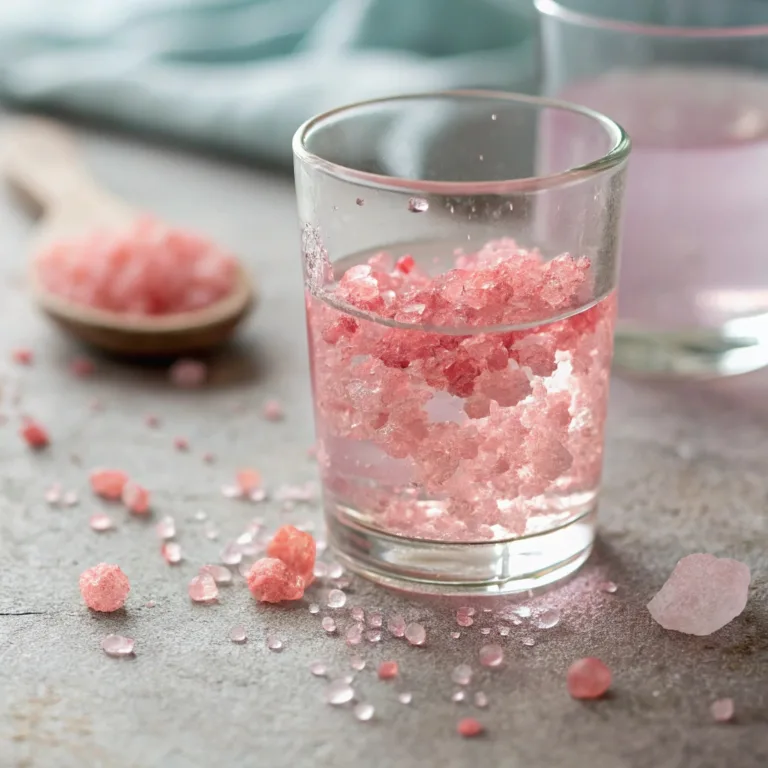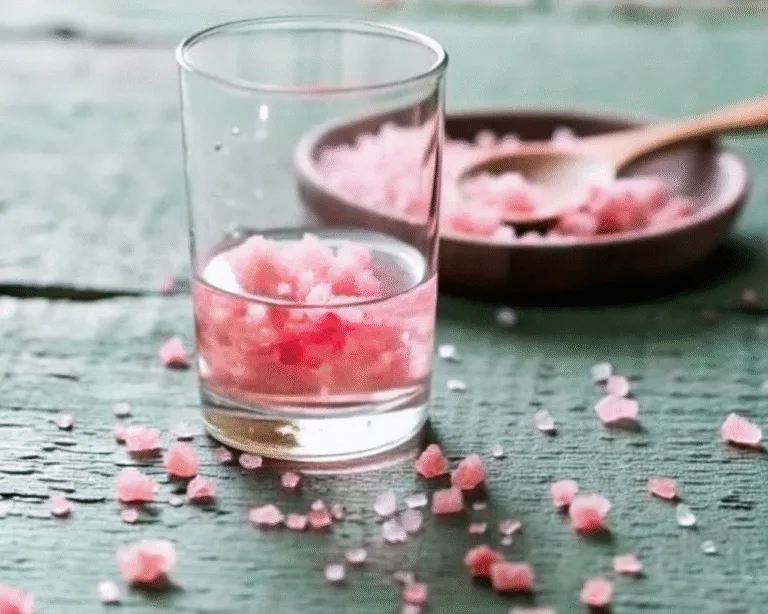Easy Japanese Clear Soup Recipe – Light, Healthy, and Soul-Soothing Broth 2025
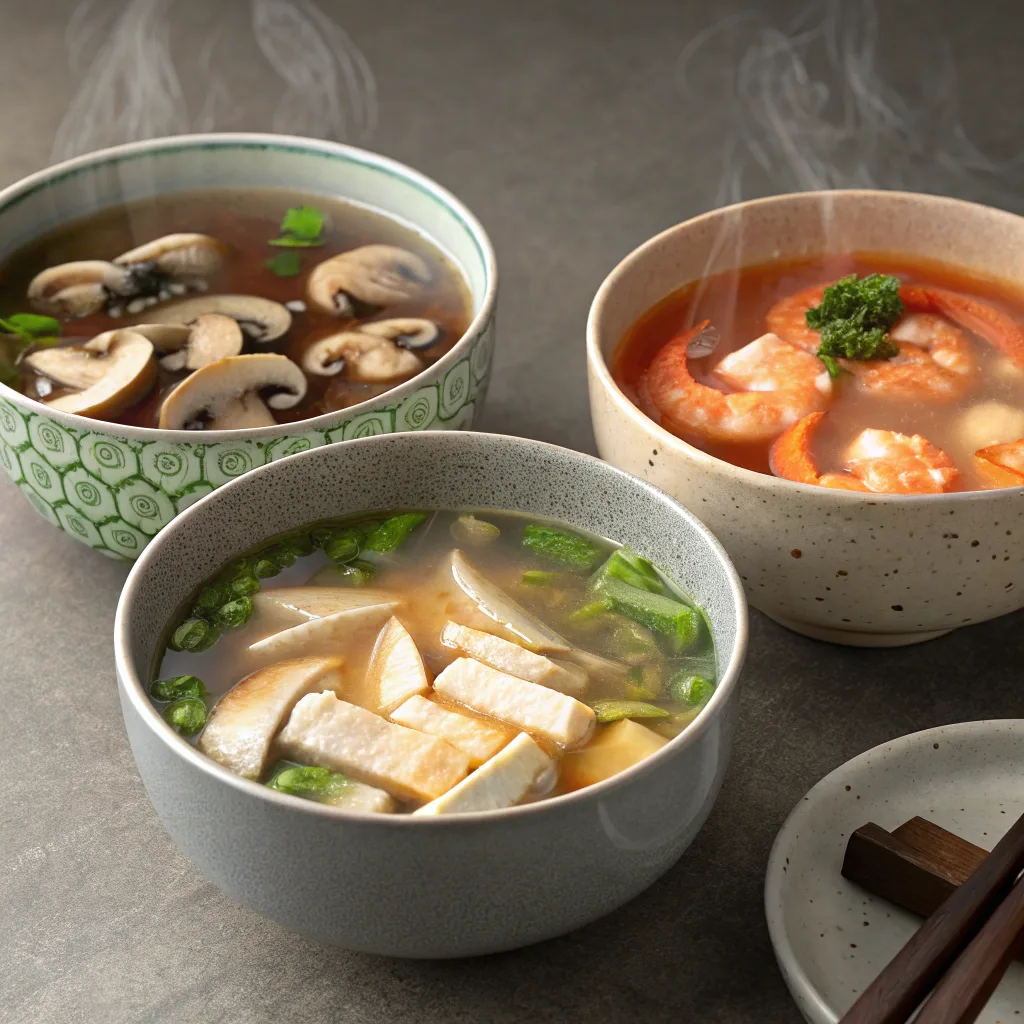
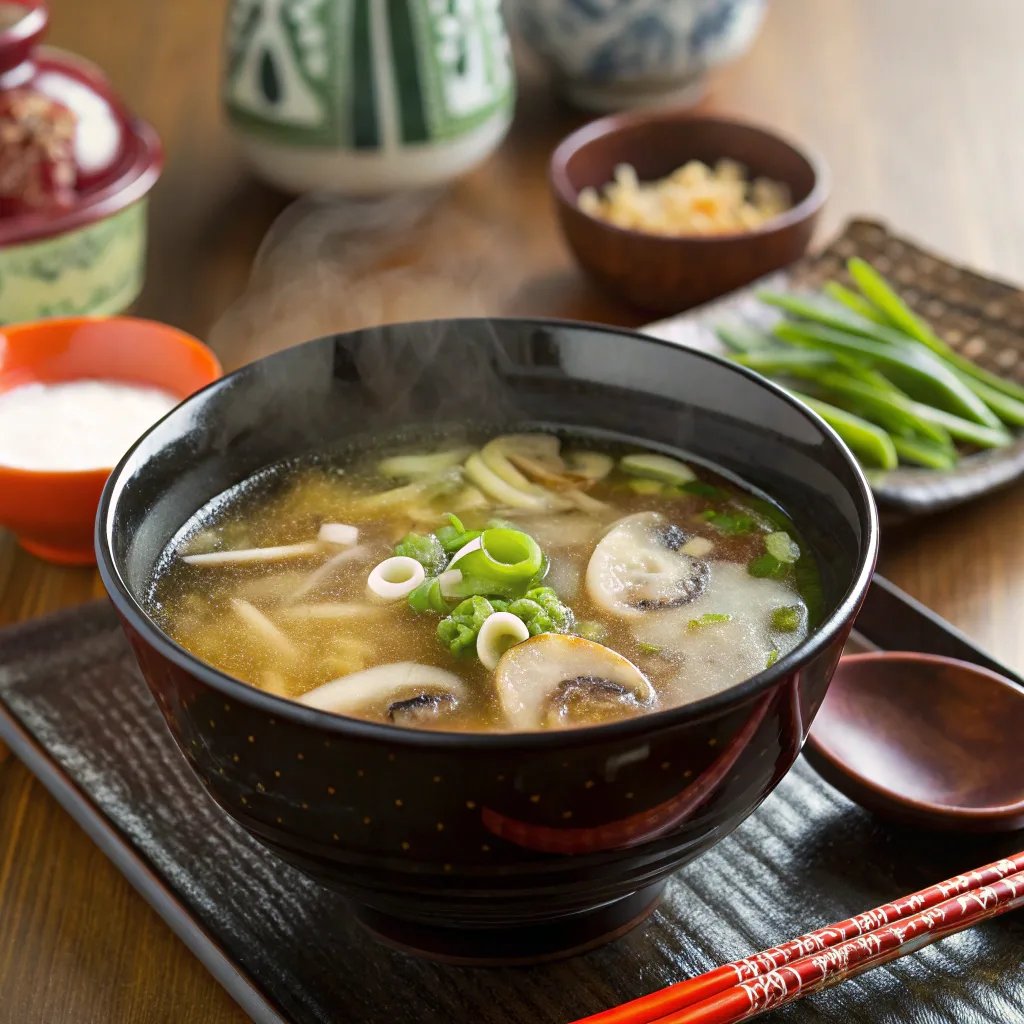
Japanese Clear Soup – A Soul‑Soothing Broth
Ingredients
Method
- 1. Wipe kombu with a dry cloth (don’t rinse).
- 2. Add kombu to water and slowly heat (don’t boil).
- 3. Remove kombu just before boiling.
- 4. Add bonito flakes and simmer 30 seconds, then turn off heat.
- 5. Strain through fine mesh for clear dashi broth.
- 6. Season with soy sauce and a pinch of salt.
- 7. Add optional garnishes and serve hot.
Nutrition
Notes
Tried this recipe?
Let us know how it was!apanese clear soup. The first time I tasted it, I was six, curled up beside my grandmother on a rainy afternoon. She ladled it gently into a small ceramic bowl, its steam mingling with the smell of rain on warm stones. That delicate, clear broth light yet full of flavor made me feel safe, seen, and deeply nourished. I didn’t know its name then. I just knew I wanted more. Years later, I learned it was called osumashi or suimono, traditional Japanese clear soup. It’s more than a starter it’s an invitation into calm, a gentle opening to a meal, and a centuries-old whisper of culinary grace.
Whether you’ve only tasted the version from a hibachi grill or you’re seeking to make the real thing at home, this article will guide you through everything you need to know about Japanese clear soup from its elegant origins to its healthful benefits.
in this recipes
in this recipes
What is Japanese Clear Soup?
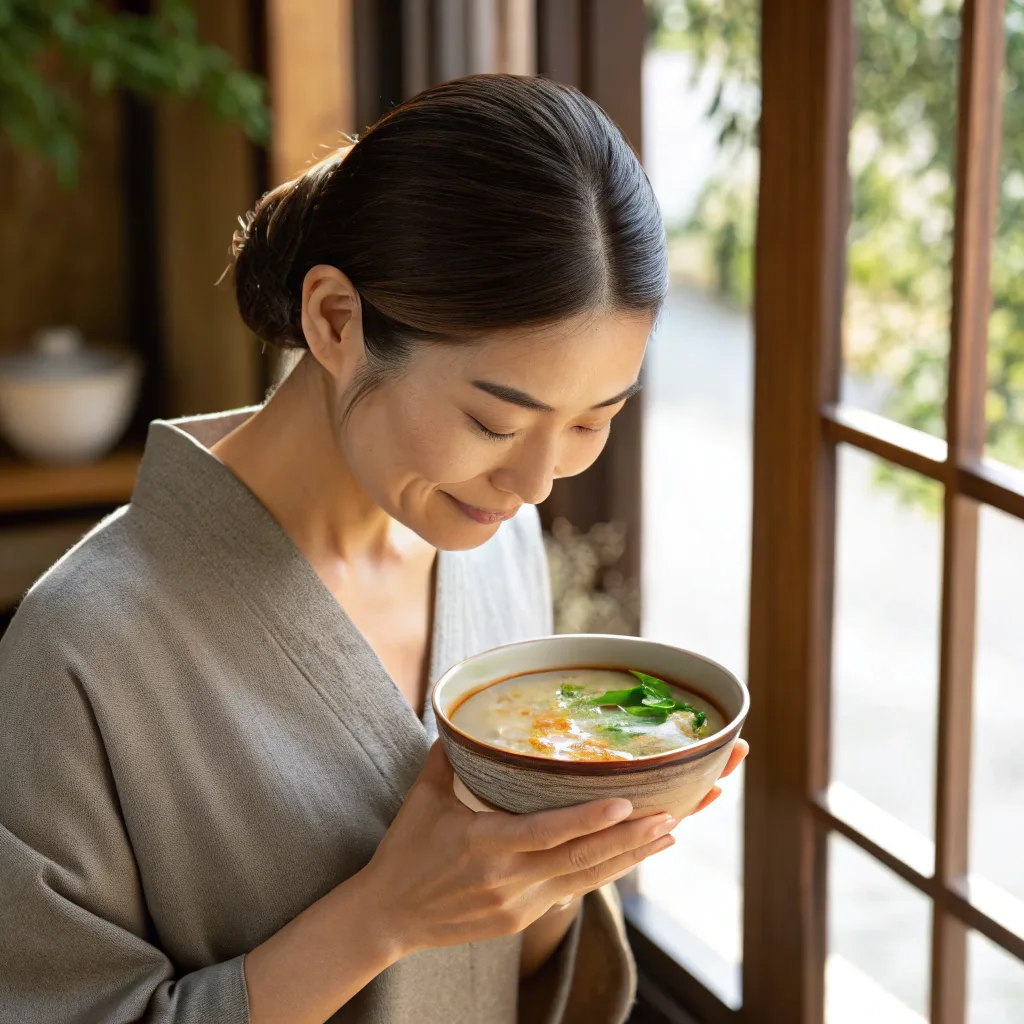
Origin and Cultural Significance
Known in Japan as “osuimono” or simply “clear soup,” Japanese clear soup is a delicate broth served as a starter or side in traditional Japanese meals. It reflects the principle of “shun” using seasonal ingredients when they’re at peak freshness. You’ll often find it served alongside sushi or tempura at high-end Japanese restaurants. Its crystal-clear appearance is not just aesthetic it’s symbolic of purity, precision, and a deep respect for ingredients.
Historically, osuimono has roots in Kaiseki, a multi-course traditional Japanese dinner where presentation, seasonality, and harmony of flavors matter just as much as taste. The soup acts as a palate cleanser and warm-up for more complex dishes to come.
Traditional Ingredients Used in Japanese Clear Soup
What sets Japanese clear soup apart is its minimalist yet umami-rich composition. The core base typically includes:
| Ingredient | Purpose |
|---|---|
| Dashi | The primary umami-rich stock |
| Bonito flakes | Adds smoky depth to the broth |
| Kombu (kelp) | Infuses subtle sea-like flavor |
| Soy sauce | Provides color and saltiness |
| Mushrooms | (Shiitake) offer umami and aroma |
| Green onions | For garnish and freshness |
| Tofu or Chicken | Optional protein addition |
This soup usually omits fat, dairy, or heavy spices, making it a clean, clear broth that’s both healing and flavorful.
The clarity of the broth comes from careful simmering and straining, a cooking method that shows restraint, patience, and respect for the natural taste of the ingredients.
Health Benefits of Japanese Clear Soup
Is Japanese Clear Soup Good for Your Stomach?
Absolutely and here’s why. Japanese clear soup is often regarded as a healing broth, especially when your digestive system needs a break. Made with a light base like dashi, which is rich in amino acids and minerals from kombu (kelp) and bonito flakes, this soup is both soothing and restorative.
Unlike heavier, cream-based soups, clear soup contains virtually no fat, dairy, or complex carbohydrates, making it ideal for:
- Post-illness recovery
- Hydration during cold or flu
- Cleansing the gut after heavy meals
- Gentle reintroduction of nutrients after fasting or stomach upset
Japanese clear soup also contains glutamate an amino acid responsible for umami which can stimulate appetite and help kickstart digestion. This makes it not just gentle on your stomach, but beneficial for gut motility and enzyme secretion.
Many Japanese households still serve clear soup as the first thing you eat when recovering from illness or digestive issues.
Looking for more inspiration? Try our Baked Cottage Cheese Eggs for another light, gut-friendly meal that pairs well with clear broth.
Low-Calorie, Gut-Friendly, and Nutrient-Rich Properties
At its core, Japanese clear soup is low-calorie with only about 10 to 25 calories per serving (without added protein or carbs). That makes it an excellent choice for those:
- On weight loss or intermittent fasting plans
- Following a low-FODMAP or anti-inflammatory diet
- Preparing for procedures that require clear liquid diets (like a colonoscopy)
In addition to being low in calories, it offers micronutrients such as:
| Nutrient | Source Ingredient | Benefit |
|---|---|---|
| Iodine | Kombu | Supports thyroid function |
| Potassium | Mushrooms, seaweed | Maintains fluid balance |
| Sodium | Soy sauce | Maintains electrolyte balance |
| Glutamic Acid | Bonito flakes, mushrooms | Supports brain and gut function |
When you pair these nutrients with its warming temperature and hydrating liquid form, it’s easy to see why Japanese clear soup is beloved as both food and natural remedy.
Don’t miss our guide to Strawberry Sangria Recipe for a refreshing drink that complements a clean, balanced meal plan.
Japanese Clear Soup vs Miso Soup
What is the Difference Between Japanese Clear Soup and Miso Soup?
It’s easy to confuse Japanese clear soup with miso soup both are staples in Japanese cuisine and often served at similar meals. However, they’re quite distinct in ingredients, appearance, and taste.
Let’s break down their key differences:
| Feature | Japanese Clear Soup | Miso Soup |
|---|---|---|
| Appearance | Transparent, clear broth | Cloudy, opaque broth |
| Base | Dashi (kombu, bonito flakes) | Dashi + fermented miso paste |
| Taste | Light, delicate, umami | Savory, salty, slightly tangy |
| Main Add-ins | Mushrooms, green onions | Tofu, seaweed, scallions |
| Fermented Ingredients | None | Yes (miso paste) |
| Use Case | Starter or cleanse | Side dish or main with rice |
While miso soup includes fermented soybean paste, giving it a thicker, creamy texture, Japanese clear soup relies purely on a strained dashi base, delivering a lighter and subtler flavor.
Flavor, Preparation, and Usage Comparison
In terms of flavor, miso soup carries a stronger umami profile due to the fermentation process. It can be salty, earthy, and robust excellent for pairing with rice or as a comforting meal on its own.
Japanese clear soup, on the other hand, is designed to complement, not overpower. That’s why it’s often served with high-flavor dishes like sushi or fried tempura providing a clean and light counterbalance to richer tastes.
Here’s how the preparation differs:
- Miso Soup:
- Prepare dashi
- Add miso paste (stir gently to dissolve)
- Add tofu, wakame, or other ingredients
- Japanese Clear Soup:
- Simmer kombu and bonito to make dashi
- Strain completely for clarity
- Season with light soy sauce and mirin
- Add simple garnish (like mushrooms or scallions)
These unique preparation methods highlight the Japanese principle of restraint letting ingredients speak for themselves rather than masking flavors.
How to Make Japanese Clear Soup at Home

Essential Ingredients for Authentic Taste
Making Japanese clear soup at home isn’t just possible it’s simple, fast, and incredibly satisfying. The key lies in using the right quality ingredients and mastering the balance of umami flavors.
Here’s what you’ll need to create a traditional batch:
| Ingredient | Quantity | Purpose |
|---|---|---|
| Kombu (dried kelp) | 1 piece (4-inch) | Base of the dashi broth |
| Bonito flakes (katsuobushi) | 1 cup | Adds smoky, savory flavor |
| Water | 4 cups | Base liquid |
| Soy sauce | 1–2 tsp | For mild salinity and umami |
| Mirin | 1 tsp (optional) | Adds slight sweetness |
| Mushrooms (shiitake/enoki) | ½ cup sliced | Flavor + texture in the soup |
| Scallions (chopped) | 2 tbsp | For garnish and freshness |
Optional add-ins:
- Silken tofu cubes
- Thinly sliced chicken
- Wakame (rehydrated seaweed)
Step-by-Step Cooking Instructions
Follow this quick method to create your own clear, comforting soup in just 20 minutes.
1. Make the Dashi Stock
- Place kombu in a pot with 4 cups of cold water.
- Let it sit for 15–20 minutes.
- Slowly bring to a simmer over medium heat. Just before boiling, remove the kombu to prevent bitterness.
2. Add Bonito Flakes
- Once the kombu is removed, add the bonito flakes.
- Let them simmer gently for 30 seconds, then remove from heat.
- Let the flakes steep for 5 minutes, then strain the broth through a fine mesh or cheesecloth to achieve crystal-clear clarity.
3. Season the Broth
- Return the strained dashi to the pot.
- Add soy sauce and mirin to taste. Start with small amounts this soup is meant to be mild.
4. Add Ingredients
- Drop in thin mushroom slices and simmer gently for 3–5 minutes until soft.
- If adding tofu or chicken, cook until warmed through (tofu) or fully cooked (chicken).
5. Garnish and Serve
- Ladle the hot soup into bowls.
- Garnish with freshly chopped scallions or a strip of yuzu peel if desired.
Best Times to Enjoy Japanese Clear Soup
Can You Have Japanese Clear Soup Before a Colonoscopy?
Yes, Japanese clear soup is an ideal choice before a colonoscopy. Doctors typically recommend consuming only clear liquids the day before the procedure to keep the digestive tract clean and reduce risks during examination.
Here’s why Japanese clear soup fits the bill perfectly:
- Transparent and strainable: The broth is free from particles and cloudiness when properly prepared.
- Low residue: Contains no fiber, making it easy for the digestive system to process.
- Hydrating and sodium-rich: Helps maintain electrolyte balance, especially if you’re fasting or on a liquid diet.
- Mild and non-irritating: Won’t trigger bloating, gas, or digestive distress common concerns before a colonoscopy.
However, it’s important to omit solid add-ins like mushrooms or tofu in this context. Stick with strained broth flavored with kombu, bonito flakes, and a little soy sauce for maximum safety and compliance.
When to Eat It: Before Meals, During Illness, or as Detox
While it’s known for its compatibility with pre-procedure diets, Japanese clear soup shines in a variety of everyday situations:
Before a Big Meal
A small bowl served before meals especially ones rich in flavor or fat can help prime your digestive system and prevent overeating. It also refreshes your palate, a practice long embraced in traditional Japanese Kaiseki dining.
During Cold or Flu
When you’re feeling under the weather, this soup provides the warmth and hydration your body craves, minus heavy ingredients that could burden your stomach. The gentle umami notes from dashi and the subtle salt from soy sauce also help replenish electrolytes.
On a Detox or Cleanse
Looking to reset after a weekend of indulgence? A few bowls of Japanese clear soup can help flush toxins, replenish minerals, and give your gut a break from digesting fats, sugars, and processed foods.
Conclusion
Whether you’re looking for a gut-friendly starter, a light addition to your sushi meal, or a healing broth to help you recover, Japanese clear soup delivers warmth, umami, and simplicity in one elegant bowl. From traditional dashi-based recipes to vegan and protein-packed variations, it’s a versatile dish you can customize and enjoy year-round.
FOR MORE RECIPES FOLLOW ME IN FACEBOOK AND PINTEREST
Frequently Asked Questions About Japanese Clear Soup
Is Japanese Clear Soup good for your stomach?
Yes, Japanese clear soup is exceptionally good for your stomach. Made with ingredients like kombu (kelp) and bonito flakes, it’s light, easily digestible, and rich in amino acids that support gut health. It’s often served when someone is sick, has digestive discomfort, or is recovering from surgery or fasting. Its low-fat, no-dairy profile also makes it gentle on sensitive stomachs.
Can you have Japanese Clear Soup before a colonoscopy?
Absolutely. Japanese clear soup, when properly strained and served without solid add-ins (like tofu or mushrooms), qualifies as a clear liquid, making it safe to consume the day before a colonoscopy. Just ensure there are no particles or cloudiness, and skip garnishes. The salty broth can also help replenish electrolytes during fasting.
What is the difference between Japanese Clear Soup and miso soup?
While both are classic Japanese soups, they differ in appearance, ingredients, and purpose:
Japanese clear soup is a transparent broth made with dashi (kombu + bonito) and light seasoning.
Miso soup is cloudy, made by dissolving fermented soybean paste (miso) into dashi.
Clear soup is often lighter and used as a palate cleanser, while miso soup is more robust and filling.
What is that Japanese soup called?
The traditional name for Japanese clear soup is “Osuimono” or simply “Suimono,” which translates to “something to sip.” It’s a standard component in Kaiseki dining and often appears in sushi restaurants. While some western menus call it “clear onion soup,” the authentic Japanese version relies more on dashi and sea-based ingredients.


